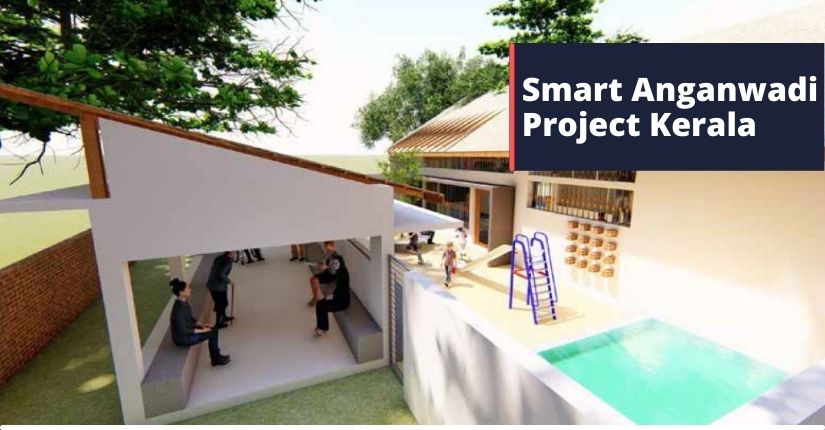From time to time, the government of India has adopted numerous policies focusing on malnutrition and hunger among children. But most of these policies are ineffective. It was in 1975 when the government adopted a new holistic policy with a compact package of services, known as the Integrated Child Development Scheme (ICDS), for the well-being of children (Dasgupta & Sachdev, 2001).
The program focuses on children below 6 years, pregnant women, lactating mothers, and adolescent girls both in rural areas and urban slums. The Anganwadi, meaning “courtyard shelter” in Indian languages, was launched under ICDS for the effective implementation of health, nutrition, and early learning initiatives (Anganwadi Functions, n.d.). Being the backbone of ICDS, many Anganwadis still lack basic infrastructure facilities such as electricity, proper buildings, play zones, and so forth. Furthermore, the pandemic has adversely affected the delivery of the services. In ensuring better amenities and service delivery in Anganwadis, the Kerala government is going the “smart” way.
Table of Contents
Smart Anganwadi Project by the Government of Kerala
In February 2021, the Department of Women and Child Development of the government, sanctioned ₹9 crores for 48 “Smart Anganwadi Project”. Under this project, the conventional Anganwadis will be transformed into smart structures with better amenities to provide more child-friendly spaces for both the mental and physical development of children. The amenities include a study hall, kitchen, dining area, storeroom, creative zone, garden, swimming pool, and outdoor play zone, as per the availability of land.
The project will be carried out in a phased manner by replacing regular structures with a more modern one, along with the financial funding worth ₹5.74 crores from the local bodies (‘Smart Anganwadis’ to be a reality in Kerala; Rs 9 crore granted, 2021). The design for the Anganwadis would be selected subject to the geographical location and availability of land. The department proposed six new designs, named in alphabetical order from A to F, which ensure quality standards, better ventilation, and safety features.
The department is collaborating with Kerala State Nirmithi Kendra and the College of Architecture Thiruvananthapuram to build “smart Anganwadis”. According to the official statements, the government is trying to cut down the number of Anganwadis in the state to ensure better and quality child care (MOHAN, 2019). There are nearly 33,000 Anganwadis in Kerala, most of them in miserable condition (MOHAN, 2019). The new “smart Anganwadi” project would be creating more than just a four-walled building for children.
Analyzing the Impact of “Smart Anganwadi” Project
The deplorable plight of Anganwadis is not just the case of Kerala. Many Anganwadis across the country face deplorable plight. With the flexible role of state governments in ICDS, the governments are granting the latest technology and gadgets to Anganwadis to tackle the digital divide. Lack of electricity is indeed a challenge for this novel opportunity. Also, the government has started to roll out children to keep track of the number of beneficiaries. For families earning meager income, Anganwadis are the only source for their children to have healthy food for their growth. A study conducted by Harvard University in 2021 states that the existence of malnutrition among children aged 0-5 is acute at the state level, district level, and village level (Raghu, 2021).
The existing pediatric malnutrition has gotten worse during the pandemic. The Department of Women and Child Development of Kerala has been delivering mid-day meals as raw materials to the beneficiaries since March 2020 (COVID-19: Anganwadi centers in Kerala deliver mid-day meals to beneficiaries at their homes, 2020). Recently, Malappuram district ICDS in Kerala has introduced the smart diet scheme with nutritious and delicious food, three times a day (Bhaskar, 2020).
A striking feature of the Anganwadi system is that it also targets the welfare of mothers. With a high risk of infant mortality and maternal mortality, regular health check-ups, and immunization, the well-being of both mother and child is ensured. The adult education of ICDS also helps women in ensuring the health of her family and the household economy (Yatsu, 2012). Self-help groups and local communities among women are helping them with social and economic empowerment. While discussing other facilities included in the scheme, it is also important to remember the need for infrastructure with specific needs for children, such as to live, play and learn. The infrastructure should also be accessible for children of all ages, abilities, and backgrounds (Tiwari, Kaur, Seth, & Surbhi, 2019). Children are open to vulnerability and there is a high possibility for abuse and violence. Improved infrastructure along with a safe and secure environment is also vital for the growth of children.
Anganwadis Need More Than Just a Makeover
Being the backbone of ICDS, it is certain that Anganwadi centers (AWCs) need to be reformed. But the effective implementation of the scheme is not just focusing on one or two aspects of the AWCs. Currently, there are almost 13.77 lakhs AWCs in which more than half of the centers lack drinking water facilities while 36% of them do not have sanitation. Lack of adequate infrastructure and assured nutritious food is making the beneficiaries think again about this free service. While it is difficult for low-income families to choose private daycare centers and nurseries, financially sound families choose the paid options. In a study conducted in Coastal-Karnataka on the utilization of ICDS, it was found that the reason for increasing enrolment in private daycare centers is the little trust in ICDS.
The study highlighted the need for improving meals provided to the beneficiaries (Anand & Verma, 2020). The number of AWCs with suitable play zones, recreations, and other learning facilities is limited. An approach that combines both play-based learning and nutritious food can make learning more fun and interesting. ICDS is a combined effort of Anganwadi workers (AWWs), ASHAs, and ANMs. But efforts for improving the skills and service condition of the workers remain indistinct. The government is also providing smartphones and tablets with installed apps for AWWs, to track the distribution of take-home rations and supplementary nutrition services. This helps in bringing further improvement in the scheme. (Anand & Verma, 2020).
Both central and state governments are taking measures in improving the condition of AWCs. In 2015 NITI Aayog proposed plans for refining drinking water and sanitation facilities, ensuring a stable power supply and availability of basic medicines in the centers. The central scheme, POSHAN Abhiyaan has adopted steps for the capacity building of AWWs. The Saksham Anganwadi Scheme by the central government aims to upgrade 2.5 lakh AWCs which promptly need a boost. For the electronic gadgets provided to AWWS, the Telangana and Andhra governments geotagged Anganwadi centers to enhance service delivery. Similarly, the Anganwadi centers of Gujarat digitized the supply chain of take-home rations and real-time data is being used to minimize stock-outs (Anand & Verma, 2020).
Adopting the Kerala Model
Through the new “Smart Anganwadi” project, Kerala is again setting a model for states to bring improvements in the AWWs. Apart from infrastructure development, Kerala is ensuring comprehensive training for AWWs and mobilizing communities to boost the performance of the centers. The AWWs in Kerala are provided with a pension, free medical care, festival allowances along with a basic monthly salary of Rs.3,500. An Anganwadi helper can be promoted to Anganwadi worker and later to supervisor if they have ten years of experience with graduation. It also generates employment for rural women.
Performance and management of the centers are constantly assessed by supervisors. Best performing centers are awarded by district collectors and panchayat members. Training programs and on-site visits by the supervisors help to address the performance of the workers and ensure effective delivery of services. Other than supervisors, retired teachers are also included in conducting training programs. Teachers are equipped with designing activities and experimenting with new designs to help children with activity-based learning. Kerala introduced ‘teacher banks’ to keep track of vacancies in AWCs. To ensure community involvement, committees composed of parents, ASHA workers, and panchayat members are created (Dang & Sarangi, 2020). Since the pandemic, the ASHA workers and AWW are facing stress from overwork. They are overworked and underpaid. The workers were also part of the COVI-19 battle in Kerala. Though they are respected for their role in society, efforts for better pay are often ignored.
Best Practices: Delhi and Rajasthan
In 2017, the Department of Women and Child Development of the NCT government announced substantial reforms in the Anganwadi centers through a massive inspection drive. The government also proposed new reformative measures such as decentralization, use of technology, and capacity building for employees. The government created an Anganwadi hub and introduced incentivized upgrades by bringing Anganwadi workers, supervisors, and Anganwadi Support & Monitoring Committee (ASMC) to work together. Furthermore, the government approved for providing smartphones with CAS (ICDS- Common Application Software) application pre-loaded and internet data pack reimbursement to Anganwadi Workers worth Rs.500/- per month for using the application (NIPCCD, 2018).
The Rajasthan government’s Department of Women and Child Development developed Social and Behaviour Change (SBC) Communication to improve the nutritional outcome of the child and mother. State Nutrition Strategy – ‘Nourishing Rajasthan – Vision 2022’ was set up to ensure the convergence through government departments to address undernutrition. Schemes such as Khushi Anganwadi Programme, Praveshotsav-Anganwadi Chalo Abhiyaan, Nanda Ghar Yojana were introduced to boost the efficiency. Rajposhan Software was developed to successfully monitor and operate Anganwadi schemes (NIPCCD, 2018).
Way Forward
Today, ICDS has expanded its horizon through adapting to modern technology and development in the field of telecommunication to reach millions of children and women by providing nutritious food and education. But the question of the scheme’s achievement still stands. Some centers don’t even have their own building and are unable to provide clean drinking water and proper sanitation. The absence of these basic needs creates a reluctance in beneficiaries. Instead of a total upgrade, what the AWCs need is improvement in their basic needs. Along with new buildings and healthy food, clean drinking water and sanitation is also inevitable. The standard of the services should be upgraded.
Southern states like Kerala, Telangana, and Tamil Nadu are comparatively better than other states in terms of skill development and capacity building of AWWs. Along with these drives, regular evaluation of the work of AWWs can help in understanding to bring further improvement in ensuring service delivery. Moreover, adopting the best practices from other states can help to advance the existing schemes or in drafting new ones (Anand & Verma, 2020). Collaboration with architectural colleges can also be adopted by bringing young minds to this initiative. As a community initiative, participation of local communities should be ensured for the scheme to attain its goal. While learning from new practices, the need for ensuring basic facilities should also be noted.

